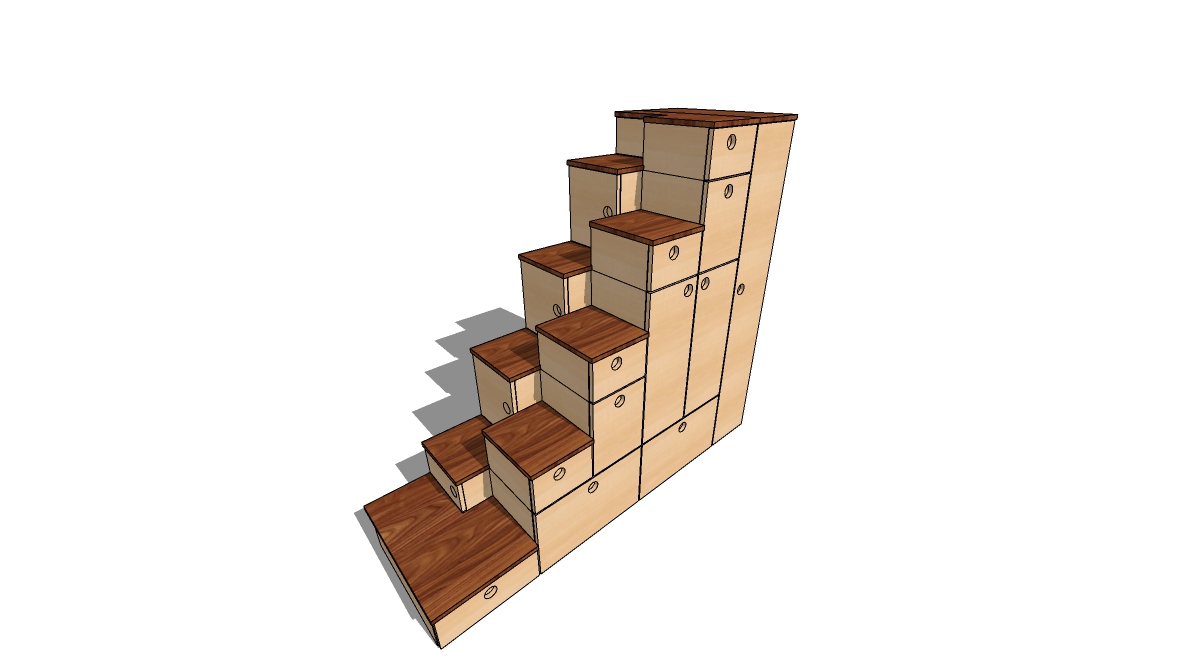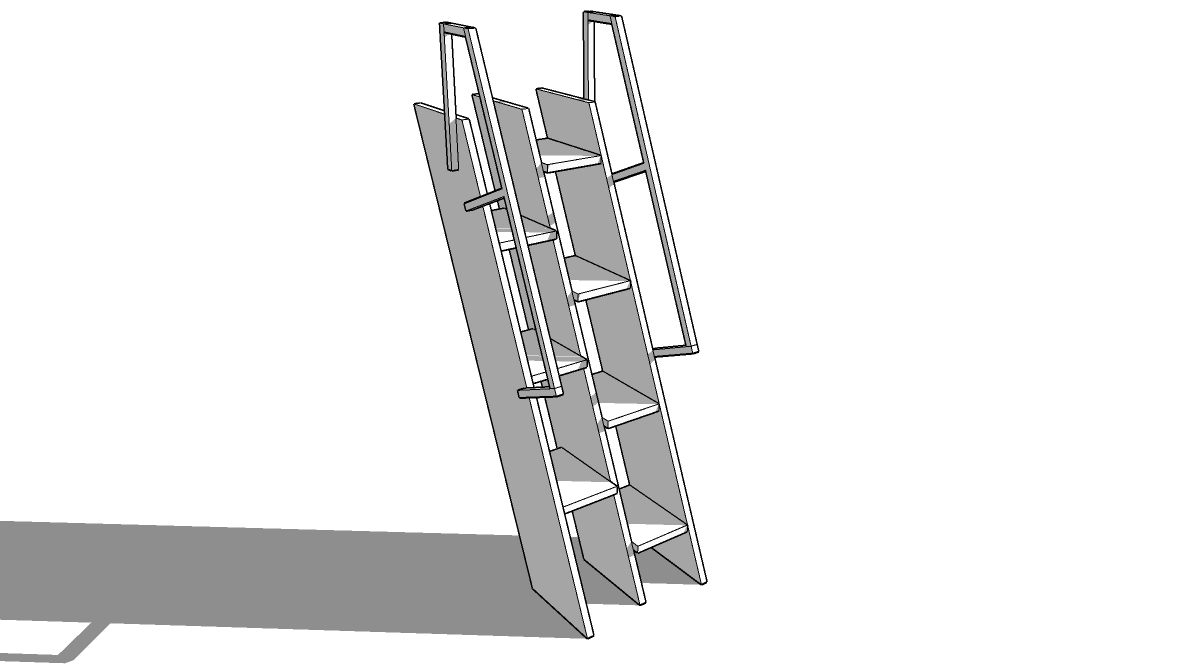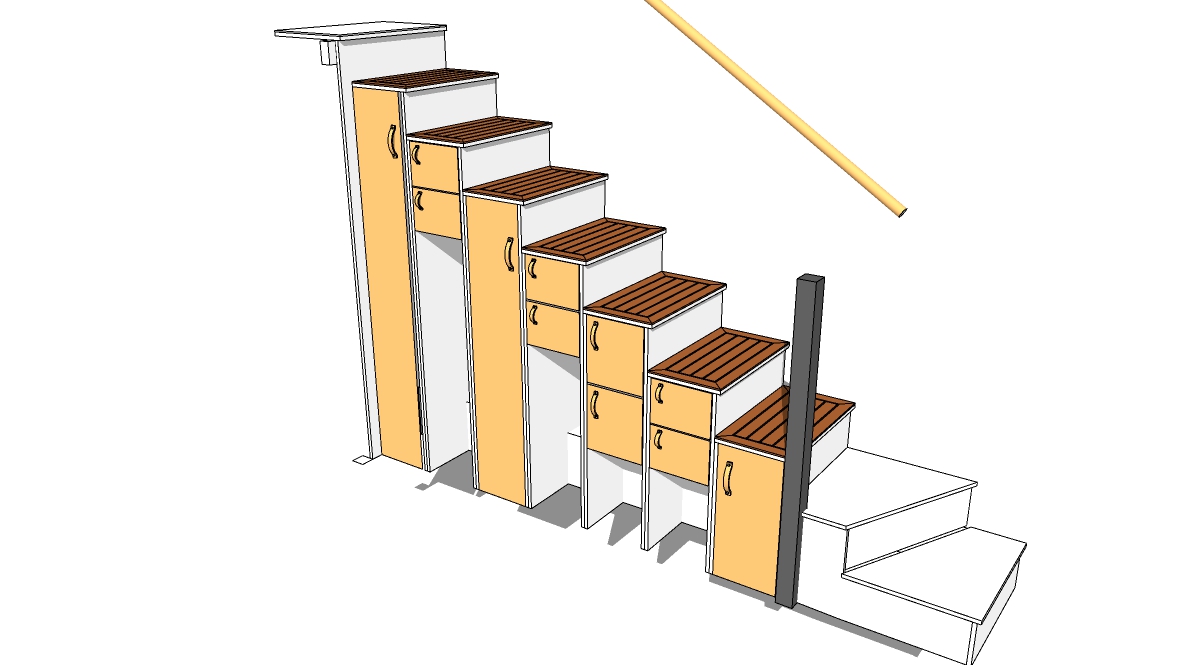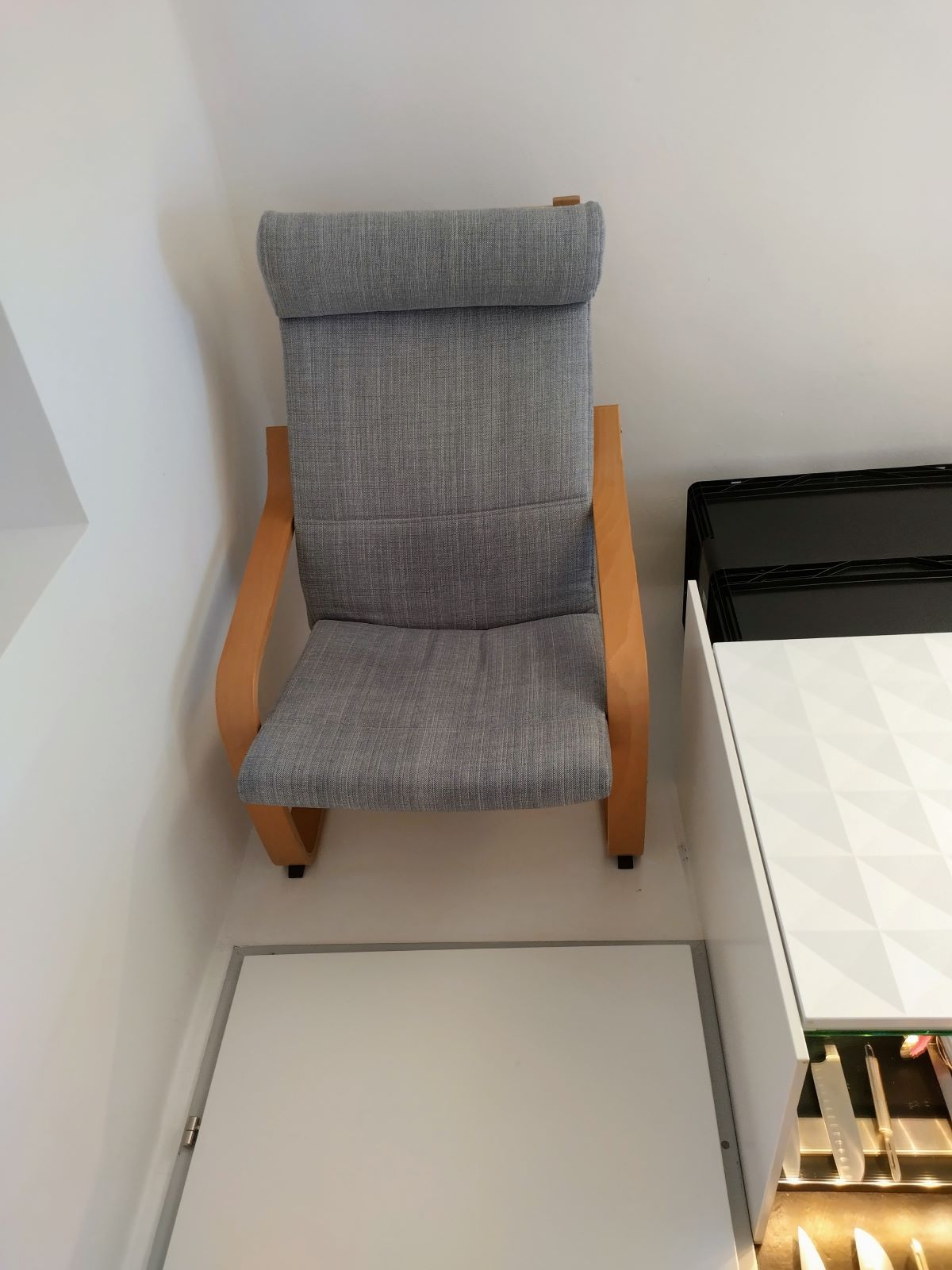Tiny House Attempt
-
It's a great idea, thank s Joe. I might just have to use that sometime.

-
For my TH, quite a bit of research went into the stairs..
I started with the Japenese Tansu Stair thing...loving the storage.

Then my timber take on a Ships Stair... tempting.

And then what I actually built was normal stairs. I def wanted the storage and I def didn't mind not having to instruct bloody people how to climb stairs. And storage to spare.
(182mm riser, 300mm go and a kosher handrail. And Legal in Oz for good reasons. (Except for the width, the regs require 900/1000mm min. My stairs are legal for storage access).

-
Thanks Baz for the images.
-
I've been watching a lot of french cleat videos lately.
My kitchen is too small for a permanent seating area. So I thought, mhh, why not turn an IKEA Pöang chair upside down and hang it from the wall with a French cleat?
Ikea Pöang chairs are comfortable, lightweight and the frame is perfect for a French cleat. It is only necessary to exchange a board on the bottom for a board with a 45° cut. The wooden frame is made of birch or beech plywood, which makes it very easy to obtain wood for the replacment part. It is also possible to simply cut a 45° angle onto the existing part.
It takes about 5 seconds and one smooth motion to raise and lower the chair. No fiddling with a folding mechanism required.
The flipped chair has a width of 82 cm. My kitchen has a height of 300 cm.
https://photos.app.goo.gl/VCFYdskLzp4uQuk3A

-
@pbacot said:
Not being interested in interaction ESPECIALLY on Social media, does not qualify you as a nihilist. it appears your lifestyle is, at least in part, hermit-like and there is no crime in that. In fact it shows a certain common sense and insight.
Keep sharing here so others can dream of the off-grid life. We may be wannabes but we'll try not to bother you.
Well mr pabacot. I thank you for that.
The interest for me is in the design of small spaces. I am 6'5". I live in small spaces.
I spent 30 years blue water sailing as crew,including 10 as owner/kipper. And 50 years woodworking on my own, designing and making as I went along.
My tiny house has been built to that experience. I would love to share that.
-
@newnoob said:
I've been watching a lot of french cleat videos lately.
I love french cleats. Strong as. Be a bit hard to sit in that chair tho' unless you had anti-grav device:)
But really, nice solution. I would be worried about it catching cooking smells?
PS: I think that small spaces should have the least amount of 'Adaptable/Configurations'.
The worst, in my opin, is the pull out bed. Unless it's a single. The next worse is the fold up table, really?
A Tiny House is not camping or making do. It's a home. -
@baz said:
Be a bit hard to sit in that chair tho' unless you had anti-grav device:)
The idea is to put it down when someone wants to sit and put it up when it's not needed. For someone of at least 170cm it's fast and simple to put it down and up. Yes cooking smells are a concern. The upholstery can be washed though. A leather cover might be a better choice.
@baz said:
PS: I think that small spaces should have the least amount of 'Adaptable/Configurations'.
The worst, in my opin, is the pull out bed. Unless it's a single. The next worse is the fold up table, really?
A Tiny House is not camping or making do. It's a home.I'd say small spaces should have as little as possible but as many as necessary space saving solutions. There smaller the space there more complicated it is to fit different functions and there more trade offs need to be accepted.
Yes, folding tables need to be cleared when folded, and pull out beds can only be used when pulled out, but folding beds or loft beds have other problems. I think that every tiny space solution inevitably comes with specific compromises that cannot be avoided. Some compromises are better than others though and it depends on the user - a cild or student in his twenties might be ok with climbing up a ladder of a loft bed but people over 40 maybe not so much.
I don't like solutions that require a lot of time to set up, concentration and complicated mechanisms.
-
There are some really tiny apartments out there but frankly I came to the conclusion that going below a certain size was pointless and I agree with the comment that there is living and camping. The house I grew up in in south London was built in the 1870's to a design by Wm Heaver who designed the Heaver estate the other side of the Clapham junction railway site. These houses have an internal room size of 12' X 10'. Two room on each floor (2) and 1 kitchen and scullery on each floor (2). Each of the rooms was intended to house one family. These were rightly condemned in late years as inhumane with nasty effects on the medical and mental health on those within.
It seems we are trying to reintroduce these conditions again by choice and while I understand building and appliance etc design have come on by leaps and bounds, believe there should be a logical limit on 'how low we can go'.
There are options and perhaps a detailed study should be conducted on the effects of living in these small properties, it might help us understand better the human side of architecture so we can reduce what is sure to be the next big health threat, either mental of medical.
-
Most people who are interested in small living spaces do so because they simply cannot afford bigger ones.
Without addressing the root causes (supply, migration, income) that drive the need for very small housing, nothing will change. However, since large population groups cannot change the conditions due to which they can't afford largeer housing, the only thing they can do is by coping with these conditions as good as possible - above all, this means "smart furniture", using multifunctional room concepts.
-
@newnoob said:
Most people who are interested in small living spaces do so because they simply cannot afford bigger ones.
Without addressing the root causes (supply, migration, income) that drive the need for very small housing, nothing will change. However, since large population groups cannot change the conditions due to which they can't afford larger housing, the only thing they can do is by coping with these conditions as good as possible - above all, this means "smart furniture", using multifunctional room concepts.
Good observations Alex. I'll be selling my house soon as I am finding it just too big for my current needs. It was a great family home while I had my wife, Pauline and my two daughters, Clara and Shelly keeping things organised. Now that my daughters have their own families and houses and Pauline has taken up residence in heaven, its just Misty (my little Westie) and me.
I will shortly be converting an office I own into a two bedroom apartment. Designing the conversion focused me on what I really needed. The main thing was the kitchen! A man's idea of what a kitchen should be and a woman's idea of the kitchen are very different!
I have also looked at 'smart furniture' and multifunctional rooms. Bedrooms in particular leave a lot to be desired. We really only use them for 8 hours a day and for those eight hours we are sleeping. I think there is scope to utilise space better in this area.
Advertisement







